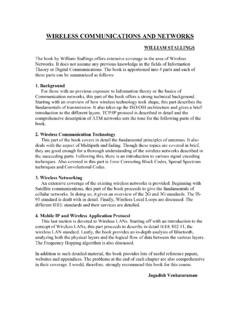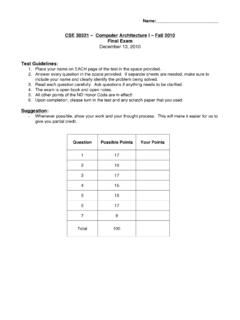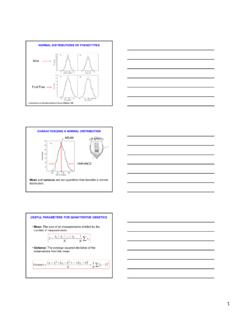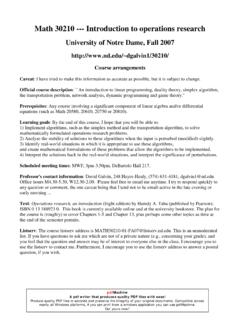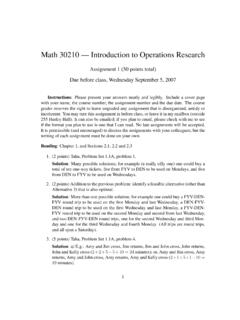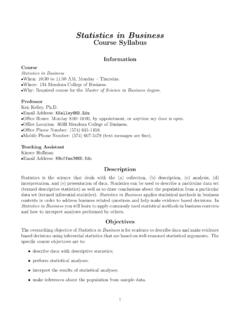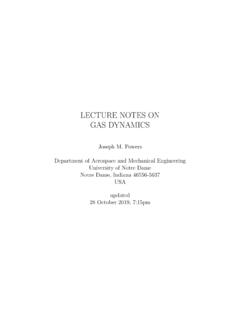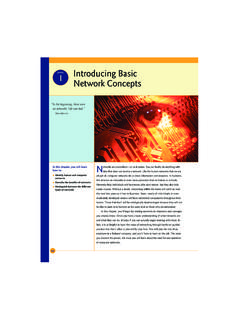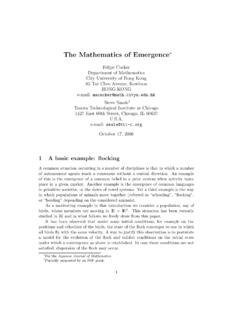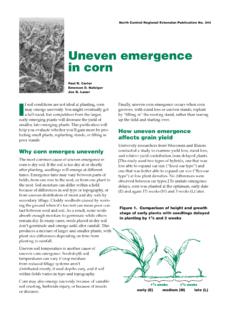Transcription of Reduction and Emergence in the Physical Sciences: Some ...
1 Reduction and Emergence in the Physical Sciences: Some Lessons from the Particle Physics Condensed MatterPhysics DebateDon HowardDepartment of Philosophy andHistory and Philosophy of Science Graduate ProgramUniversity of Notre DameWhence, then, do my errors arise? Only from the fact that the will is much more ample and far-reaching than the understanding, so that I do not restrain it within the same limits but extend it evento those things which I do not understand. Being by its nature indifferent about such matters, it veryeasily is turned aside from the true and the good and chooses the false and the evil. And thus ithappens that I make mistakes and that I Descartes, Meditations on First Philosophy, Meditation Four, Of the True and the False Introduction: A Note of CautionThe task that I set for myself today is a mundane philosophical one getting clear aboutfundamental concepts, developing a taxonomy of viewpoints, assessing the validity of arguments forthose views, and handicapping the odds for one or another of them to emerge triumphant.
2 The arenais the much contested one of questions about Reduction and Emergence in the Physical sciences, morespecifically the relationship between particle physics and condensed matter physics. The main pointthat I wish to make is that we know so little about that relationship, and that what we do knowstrongly suggests that condensed matter phenomena are not emergent with respect to particle physics,that we should be wary of venturing hasty generalizations and of making premature extrapolationsfrom physics to the biosciences, the neurosciences, and Howard. Reduction and Emergence in the Physical Sciences. Page 2 San Francisco, October 2003 Caution is the byword. Caution is called for because the academy is yet again seized by anenthusiasm. Seventy years ago it was complementarity (Bohr 1933). Thirty years ago catastrophetheory (Thom 1975). Twenty years ago fractals (Mandelbrot 1983). Yesterday it was cellularautomata (Wolfram 2002).
3 Today it is complexity theory, cooperative phenomena, and non-lineardynamics (Scott 1999 and 2003). Enthusiasm is good. It promotes creativity. It stimulatesimagination. It gives one strength to carry on in the face of dogmatic opposition. But Descartes himself no intellectual wallflower taught us in the Meditations that error is a consequence of thewill outrunning the understanding. Like Faust, many of us want to know was die Welt im Innerstenzusammenh lt. Let s just be sure that our desire to solve the riddle of the universe doesn t get toofar out in front of what we actually mentioned, the specific place where I want today to make the case for caution is at theinterface between particle physics and solid state or condensed matter physics. Here is where we findsome of the boldest assertions that physics has demonstrated Emergence . Various salient physicalproperties of the mesorealm, properties such as superconductivity and superfluidity are held to beemergent with respect to particle physics.
4 Such properties are said to exemplify coherent states ofmatter or long-range cooperative phenomena of a kind often associated with systems obeying a non-linear dynamics. Such coherent states are said not to be explicable in terms of the properties of themolecular, atomic, or still more elementary constituents of superconductors or superfluids. I urgecaution here for two reasons: (1) The physics of the mesorealm is not well enough established tolicense any inferences about the essential and distinguishing properties of matter at this intermediatescale. (2) That coherent states of matter are not to be explained at the level of particle physics hasDon Howard. Reduction and Emergence in the Physical Sciences. Page 3 San Francisco, October 20031 Batterman 2002 and Silberstein 2002 are useful not been demonstrated. On the contrary, it is precisely at the level of particle physics that wedo find compelling Physical arguments and empirical evidence of the holism said wrongly, Ithink to be distinctive of mesophysics.
5 We ve had a name for such microphysical holism since name is entanglement. And at least superconductivity and superfluidity, if not also various otherphenomena in the realm of condensed matter physics, find their proper explanation as mesoscopicmanifestations of microscopic I get ahead of myself. Let s slow down and begin with some of the philosopher s favoritetools or toys; let s begin with some Conceptual Preliminaries: Reduction , Supervenience, and EmergenceContemporary discussions of emergent phenomena often start with a helpful distinctionbetween two different relationships that might obtain between two different levels of description,intertheoretic Reduction and Reduction is a logical relationship between theories. In the classicformulation owing to Ernest Nagel, theory TB, assumed correctly to describe orexplain phenomena at level B, reduces to theory TA, assumed correctly to describe orexplain phenomena at level A, if and only if the primitive terms in the vocabulary ofTB are definable via the primitive terms of TA and the postulates of TB are deductiveDon Howard.
6 Reduction and Emergence in the Physical Sciences. Page 4 San Francisco, October 20032 Nagel 1961, 345-366. Some details of Nagel s formulation irrelevant for our purposes are Davidson 1970 is generally regarded as first introducing this specific notion of supervenience, though it isimplicit in many earlier literatures. For an overview, see Blackburn of the postulates of As normally formulated, this definition ofreduction assumes a syntactic view of theories as sets of statements or is an ontic relationship between structures. A structure, Sx, is a set ofentities, Ex, together with their properties and relations, PRx. A structure, SB,characteristic of one level, B, supervenes on a structure, SA, characteristic of anotherlevel, A, if and only if the entities of SB are composed out of the entities of SA and theproperties and relations, PRB, of SB are wholly determined by the properties andrelations, PRA, of SA.
7 One way to understand the relevant sense of determination is as requiring that there be no differences at level B, say different values of aparameter such as the temperature of a gas, without there being a correspondingdifference at level A, say in the mean kinetic energy of the molecules constituting is no straightforward relationship between Reduction and supervenience. One mightthink that Reduction implies supervenience, in the sense that, if theory TB reduces to theory TA, thenthe structures, SB, assumed correctly to be described or explained by TB, supervene on the structures,SA, assumed correctly to be described or explained by TA. This need not be the case, however, if someof the properties and relations constitutive of SB depend on boundary conditions. Not all structureDon Howard. Reduction and Emergence in the Physical Sciences. Page 5 San Francisco, October 20034 Still finer distinctions among varieties of Emergence are encountered in various other literatures, especiallyin the philosophy of mind.
8 Silberstein 2002 is, again, a good place to start for a more comprehensive survey. Thedistinction between R- Emergence and S- Emergence suffices for present nomic. Think of global metrical structure in big-bang cosmology or edge state excitations in thefractional quantum Hall effect. That supervenience does not imply Reduction should be even clearer,for the properties and relations, PRB, constitutive of structure SB can be wholly determined by theproperties and relations, PRA, of SA without there being laws governing PRB that are deductiveconsequences of laws governing PRA, perhaps because there are no exceptionless laws can be asserted either as a denial of intertheoretic Reduction or as a denial ofsupervenience. There being no necessary relationship between Reduction and supervenience, therewill, in consequence, be no necessary relationship between the corresponding varieties of Emergence ,which must, therefore, be distinguished, the claim of what we might term R- Emergence being adenial of Reduction , and what we might terms S- Emergence being a denial of about the relationship between different levels of description in terms ofintertheoretic Reduction has the advantage of clarity, for while it might prove difficult actually todetermine whether a postulate at level B is derivable from the postulates of level A as is the casewith the ergodic hypothesis, which is to be discussed shortly , we at least know what we mean byderivability and definability as relationships between syntactic objects like terms and statements,since we know by what rules we are to judge.
9 The chief disadvantage of this way of thinking aboutinterlevel relationships is that one is hard pressed to find a genuine example of intertheoreticreduction outside of mathematics, so to assert Emergence as a denial of Reduction is to assertDon Howard. Reduction and Emergence in the Physical Sciences. Page 6 San Francisco, October 2003something trivial and uninteresting. Yet another disadvantage is the restriction to theoriesrepresented syntactically as sets of statements or propositions, central among which are statementsof laws, for there is reason to think that many important scientific theories evolution is an often citedexample are not best understood in this way. Later on I will say a word or two about the possibleadvantages of a semantic view of theories, whereupon a theory is conceived as a set of chief advantage of thinking about interlevel relationships from the point of view ofsupervenience is that it seems to many to capture well our pre-analytic intuitions, such as those aboutthe relationship between heat and agitated molecular motion.
10 The chief disadvantage of so posingthe question of interlevel relationships is that it is not always clear by what general rules we are toassess claims about supervenience and its denial, so in asserting Emergence as a denial ofsupervenience one risks asserting something validated by little more than intuition. There are,however, some reasonably clear paradigm cases of Emergence as a failure of supervenience, the mostimportant for our purposes being quantum mechanical entanglement, which is shortly to intertheoretic Reduction and supervenience along with the respective notionsof Emergence is a big step in the direction of clarity and understanding. For example, I will argue thatwhile condensed matter physics does not obviously reduce to particle physics, phenomenacharacteristic of condensed matter physics such as superfluidity and superconductivity do superveneon Physical properties at the particle physics level and hence are not emergent with respect to particlephysics in the sense of S- Emergence .
